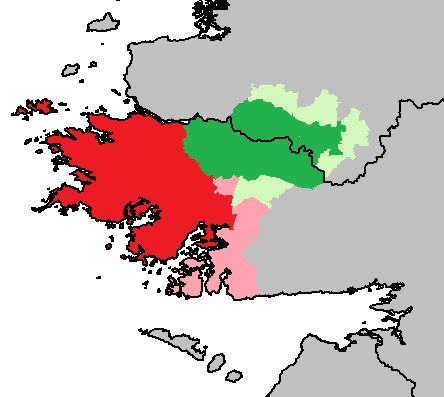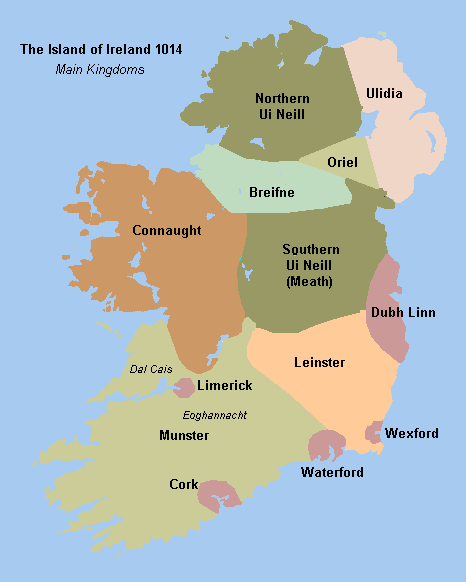|
Conmhaícne
The Conmaicne (; ) were a people of early Ireland, perhaps related to the Laigin, who dispersed to various parts of Ireland. They settled in Connacht and Longford, giving their name to several Conmaicne territories. T. F. O'Rahilly's assertion the Conmaicne were non-Goidelic is not widely accepted. Etymology Their name originates from a mythical ancestor known as ''Conmac(c)'' (), meaning "hound-son" (, prefix form of n-stem hound; , son). Conmac(c) descended from Fergus mac Róich and Queen Medb of Connacht. However, Walsh stated "Conmac son of Fergus is a genealogical fiction". The word ''Conmaicne'' means "progeny of Conmac" (''-ne'', a progeny). The name in Old Irish spelling contains ''m'' (without a following ''h'') and ''c'' (or more etymologically, ''cc''), thus Old Irish Conmac(c) and Conmaic(c)ne, but in Modern Irish spelling contains ''mh'' (with unetymological ''h'' as a sign of lenition) and single ''c'', thus Conmhac and Conmhaicne). Branches Branches of the C ... [...More Info...] [...Related Items...] OR: [Wikipedia] [Google] [Baidu] |
Conmhaícne Angaile
The Conmhaícne Angaile (the 'Conmhaícne descended from Angaile') were an early people of Ireland. Their tuath comprised the territory of Annaly, now County Longford. Origin The Conmhaícne or Conmaícne were a people of early Ireland, perhaps related to the Laigin, who dispersed to various parts of Ireland. They settled in Connacht and Longford, giving their name to several Conmaícne territories. Other branches of the Conmhaícne were located in County Galway, Roscommon, Mayo, and Leitrim. Territory Their territory was bounded by native Irish forests in places, by the River Shannon and Conmaícne of Maigh Rein to the east, Breifne O'Reilly to the north, and Leinster to the east. Taoiseach The chief Conmaícne family were the Ó Fearghail, who descended from the great-grandson of Angaile. Diocese The Diocese of the Conmaícne (or Ardagh) was established in 1111 as the see for east Connacht. Fourteen years later, at the Synod of Kells-Mellifont, it's area was reduced ... [...More Info...] [...Related Items...] OR: [Wikipedia] [Google] [Baidu] |
Connemara
Connemara ( ; ) is a region on the Atlantic Ocean, Atlantic coast of western County Galway, in the west of Ireland. The area has a strong association with traditional Irish culture and contains much of the Connacht Irish-speaking Gaeltacht, which is a key part of the identity of the region and is the largest Gaeltacht in the country. Historically, Connemara was part of the territory of Iar Connacht (West Connacht). Geographically, it has many mountains (notably the Twelve Pins), peninsulas, coves, islands and small lakes. Connemara National Park is in the northwest. It is mostly rural and its largest settlement is Clifden. Etymology "Connemara" derives from the tribal name , which designated a branch of the , an early tribal grouping that had a number of branches located in different parts of . Since this particular branch of the lived by the sea, they became known as the (sea in Irish is , genitive case, genitive , hence "of the sea"). Definition One common definition o ... [...More Info...] [...Related Items...] OR: [Wikipedia] [Google] [Baidu] |
Fergus Mac Róich
Fergus mac Róich/Róigh (literally "Virility, manliness, son of great stallion") is an Irish hero and a character in the Ulster Cycle of Irish mythology. Formerly the king of Ulaid, Ulster, he is tricked out of the kingship and betrayed by Conchobar mac Nessa, becomes the ally and lover of Conchobar's enemy, queen Medb of Connacht, and joins her expedition against Ulster in the ''Táin Bó Cúailnge''. Fergus is described as being of huge size and sexual potency.Whitley Stokes (scholar), Whitley Stokes (ed. & trans.)"The Tidings of Conchobar son of Ness" ''Ériu (journal), Ériu'' vol. 2, 1908 This leads him into many a precarious situation as in the story of the ''Táin Bó Flidhais''. King of Ulster Fergus becomes king of Ulster after his predecessor, Eochaid Sálbuide, is killed, along with the High King of Ireland, High King Fachtna Fáthach, by Eochu Feidlech in the Battle of Leitir Ruad. While king, he desires Eochaid Sálbuide's daughter Ness (Irish mythology), Ness, but ... [...More Info...] [...Related Items...] OR: [Wikipedia] [Google] [Baidu] |
Dunmore, County Galway
Dunmore () is a town in County Galway, Ireland. It is located on the N83 road (Ireland), N83 national secondary road at its junction with the R328 road (Ireland), R328 and R360 road (Ireland), R360 Regional road (Ireland), regional roads. The town is in a townland and Civil parishes in Ireland, civil parish of the same name. The town belongs to an ancient tuath called Conmhaícne Dúna Móir, Conmhaícne Dúna-Móir and Cenél Dubáin, ruled by Uí Conchobair of Ui Briuin, Ui Briuin Ai from the 12th century, and a capital of Connacht for a time. King Tairrdelbach Ua Conchobair died here in 1156. Until the early 1980s, the N83 through Dunmore was on the main road from Sligo to Galway. Improvements to the N17 road (Ireland), N17 route through Knock, County Mayo, Knock and Claremorris reduced the amount of traffic on the N83. History The ruins of Dunmore Castle are situated on a small hillock outside the village. The first castle at this site was built by the Anglo-Norman de-Birmin ... [...More Info...] [...Related Items...] OR: [Wikipedia] [Google] [Baidu] |
Connacht
Connacht or Connaught ( ; or ), is the smallest of the four provinces of Ireland, situated in the west of Ireland. Until the ninth century it consisted of several independent major Gaelic kingdoms (Uí Fiachrach, Uí Briúin, Uí Maine, Conmhaícne, and Delbhna). Between the reigns of Conchobar mac Taidg Mór (died 882) and his descendant, Aedh mac Ruaidri Ó Conchobair (reigned 1228–33), it became a kingdom under the rule of the Uí Briúin Aí dynasty, whose ruling sept adopted the surname Ua Conchobair. At its greatest extent, it incorporated the often independent Kingdom of Breifne, as well as vassalage from the lordships of western Mide and west Leinster. Two of its greatest kings, Tairrdelbach Ua Conchobair (1088–1156) and his son Ruaidri Ua Conchobair (c. 1115–1198) greatly expanded the kingdom's dominance, so much so that both became High King of Ireland. The Kingdom of Connacht collapsed in the 1230s because of civil war within the royal dynasty, which enab ... [...More Info...] [...Related Items...] OR: [Wikipedia] [Google] [Baidu] |
Conmhaícne Ceara
The Conmhaícne Ceara or Conmaicne Cúile Ceara () were an early people of Ireland. Their tuath comprised some or all of the barony of Carra, County Mayo. Origin The Conmhaicne or Conmaicne were a people of early Ireland, perhaps related to the Laigin, who dispersed to various parts of Ireland. They settled in Connacht and Longford, giving their name to several Conmaicne territories. Other branches of Conmaicne were located in County Galway, Roscommon, Mayo, and Leitrim. Old Irish names for ''Conmaicne Carra'' appear in Tírechán collections, the Book of Leinster and other old manuscripts- * in Tirechan's Breverium. * in Tirechan's Vita Tripartita. * . * ; * . * . In his translation of the Book of Fenagh, John O'Donovan (scholar), O'Donovan identifies the Cinel-Cirend with "Crich-mac-Eric" ("Ulster"), but this is surely wrong. Paul Walsh (priest), Walsh states the ''"Conmaicne of Crich Meic Eircce is explained by Cenel Meic Eircce which is equated with the Men of Cera, they g ... [...More Info...] [...Related Items...] OR: [Wikipedia] [Google] [Baidu] |
County Mayo
County Mayo (; ) is a Counties of Ireland, county in Republic of Ireland, Ireland. In the West Region, Ireland, West of Ireland, in the Provinces of Ireland, province of Connacht, it is named after the village of Mayo, County Mayo, Mayo, now generally known as Mayo Abbey. Mayo County Council is the Local government in the Republic of Ireland, local authority. The population was 137,231 at the 2022 census of Ireland, 2022 census. The boundaries of the county, which was formed in 1585, reflect the Mac William Íochtar lordship at that time. Geography It is bounded on the north and west by the Atlantic Ocean; on the south by County Galway; on the east by County Roscommon; and on the northeast by County Sligo. Mayo is the third-largest of Ireland's 32 counties in area and 18th largest in terms of population. It is the second-largest of Connacht's five counties in both size and population. Mayo has of coastline, or approximately 21% of the total coastline of the State. It is one of ... [...More Info...] [...Related Items...] OR: [Wikipedia] [Google] [Baidu] |
County Longford
County Longford () is a Counties of Ireland, county in Republic of Ireland, Ireland. It is in the Provinces of Ireland, province of Leinster. It is named after the town of Longford. Longford County Council is the Local government in the Republic of Ireland, local authority for the county. The population of the county was 46,634 at the 2022 census. The county is based on the historic Gaelic Ireland, Gaelic territory of Annaly (''Anghaile''), formerly known as Tethbae, Teffia (''Teathbha''). Geography Most of Longford lies in the basin of the River Shannon with Lough Ree forming much of the county's western boundary. The north-eastern part of the county, however, drains towards the River Erne and Lough Gowna. Lakeland, bogland, pasture-land and wetland typify Longford's generally low-lying landscapes: the highest point of the county is in the north-west – Carn Clonhugh (also known as Cairn Hill or Corn Hill) between Drumlish and Ballinalee in the parish of Killoe, at . Cairn H ... [...More Info...] [...Related Items...] OR: [Wikipedia] [Google] [Baidu] |
County Galway
County Galway ( ; ) is a Counties of Ireland, county in Republic of Ireland, Ireland. It is in the Northern and Western Region, taking up the south of the Provinces of Ireland, province of Connacht. The county population was 276,451 at the 2022 census. There are several Gaeltacht, Irish-speaking areas in the west of the county. The traditional county includes the city of Galway, but the city and county are separate local government areas, administered by the Local government in the Republic of Ireland, local authorities of Galway City Council in the urban area and Galway County Council in the rest of the county. History The first inhabitants in the Galway area arrived around the 5th millennium BC. Shell middens indicate the existence of people as early as 5000 BC. The county originally comprised several kingdoms and territories which predate the formation of the county. These kingdoms included , , , , and . County Galway became an official entity around 1569 AD. The region ... [...More Info...] [...Related Items...] OR: [Wikipedia] [Google] [Baidu] |



